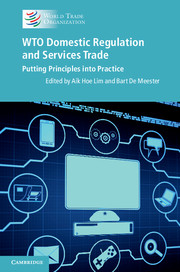Book contents
- Frontmatter
- Contents
- List of contributors
- Foreword
- Disclaimer
- Acknowledgements
- List of abbreviations
- 1 An introduction to domestic regulation and GATS
- Part I Impediments to services trade, regulatory theory and principles
- Part II Legal perspectives on WTO principles and domestic regulations
- Part III Case studies
- 8 Legal services in the United States
- 9 Telecommunications reform in China: fostering competition through state intervention
- 10 Information communications technology: the Mauritian experience of regulation and reform
- 11 Regulation of postal services in a changing market environment: lessons from Australia and elsewhere
- 12 Mobile money services provision in East Africa: the Ugandan experience
- 13 Financial services liberalization and regulation in Japan: implications for future negotiation on market access and domestic regulations
- 14 Domestic regulations in Malaysia’s higher education sector
- 15 Domestic regulations and India’s trade in health services: a study of hospital and telemedicine services
- 16 Operating integrated logistics services in a fragmented regulatory environment: what is the cost?
- 17 Domestic regulation of retail food distribution services in Israel: the missing link between food prices and social protest
- 18 Regulatory impact analysis: addressing the trade and regulatory nexus
- Part IV Concluding remarks
- Index
- References
15 - Domestic regulations and India’s trade in health services: a study of hospital and telemedicine services
Published online by Cambridge University Press: 05 April 2014
- Frontmatter
- Contents
- List of contributors
- Foreword
- Disclaimer
- Acknowledgements
- List of abbreviations
- 1 An introduction to domestic regulation and GATS
- Part I Impediments to services trade, regulatory theory and principles
- Part II Legal perspectives on WTO principles and domestic regulations
- Part III Case studies
- 8 Legal services in the United States
- 9 Telecommunications reform in China: fostering competition through state intervention
- 10 Information communications technology: the Mauritian experience of regulation and reform
- 11 Regulation of postal services in a changing market environment: lessons from Australia and elsewhere
- 12 Mobile money services provision in East Africa: the Ugandan experience
- 13 Financial services liberalization and regulation in Japan: implications for future negotiation on market access and domestic regulations
- 14 Domestic regulations in Malaysia’s higher education sector
- 15 Domestic regulations and India’s trade in health services: a study of hospital and telemedicine services
- 16 Operating integrated logistics services in a fragmented regulatory environment: what is the cost?
- 17 Domestic regulation of retail food distribution services in Israel: the missing link between food prices and social protest
- 18 Regulatory impact analysis: addressing the trade and regulatory nexus
- Part IV Concluding remarks
- Index
- References
Summary
Introduction
Estimated at US$36 billion and employing over four million people, the Indian health care sector is one of the largest service sectors in the economy today. With a compound annual growth rate (CAGR) of 15 per cent, the Indian health care sector is expected to reach US$280 billion by 2020. A 2003 report titled India’s New Opportunity: 2020, prepared jointly by the All India Management Association, Boston Consulting Group and the Confederation of Indian Industries, predicts that over 40 million new jobs and US$200 billion increased revenues are expected to be generated by the Indian services sector by 2020, and the health care sector will play an important role in generating these jobs and revenues (AIMA/BCG 2003). Hence, this sector is predicted to grow rapidly and is seen to have considerable potential due to the growing demand for health care services in India. The reasons are many, including rising incomes, a growing propensity to spend on health care, an emergence of lifestyle-related diseases, and demographics.
Given the growing demand, the emergence of reputable private operators, and the vast investment needs in this sector, there has been growing interest among foreign investors and non-resident Indians to enter the Indian health care market to explore investment opportunities in areas such as drugs and pharmaceuticals, medical devices and hospitals. In the hospitals and medical devices sector alone, at least twenty international groups are competing to have a share in the Indian health care market. These investors enter mainly through joint ventures with Indian companies but also through technology and training collaborations (Chanda 2010). Another emerging field is telemedicine, which is about providing health care at a distance, either online or over the phone. In this sector, India has the potential to provide state-of-the-art services at cost-effective rates.
- Type
- Chapter
- Information
- WTO Domestic Regulation and Services TradePutting Principles into Practice, pp. 254 - 269Publisher: Cambridge University PressPrint publication year: 2014



